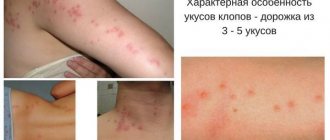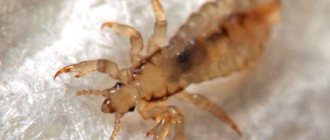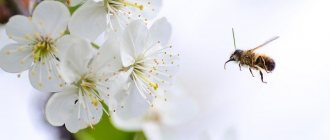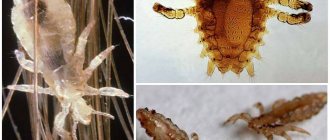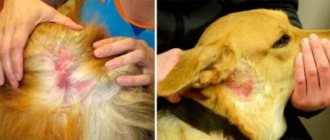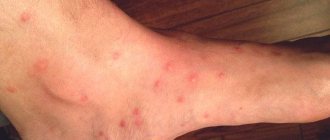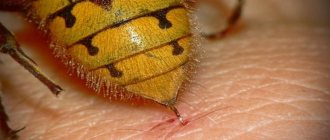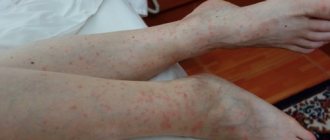Bedbugs and fleas are parasites that feed on blood. They often live in human homes. Moreover, the former prefer the blood of the owner himself, while the latter parasitize pets. But in the absence of animals, fleas can also bite humans. It is not always possible to quickly identify insects by marks on the skin, since it is quite difficult for an inexperienced person to distinguish a flea bite from a bug bite. Their characteristic features will help you recognize parasites.
Bedbugs and fleas can bite humans.
How to distinguish a bug from a flea
If bite marks are found on the body, it is necessary to determine what insects have appeared in the house.
The following characteristics will allow you to do this:
- Appearance. The bed bug has the shape of an oval, flattened in a horizontal plane. It can reach 1 cm in length. The bright red-brown color and low speed of movement make it easy to detect insects in breeding areas. Unlike a bedbug, a flea does not exceed 5 mm in length. The parasite has a laterally flattened body, covered with bristles and a chitinous shell, and a dark coloration; it moves quickly and jumps high.
- Features of reproduction. Bed bugs are insects whose type of metamorphosis involves incomplete transformation. That is, larvae immediately emerge from the eggs and are capable of biting humans. Such insects are tiny in size, devoid of color and hard coverings. The growth of the parasite is accompanied by molting, during which it sheds its old covering. Metamorphosis of fleas involves complete transformation. To feed on its own, the insect must go through the stages of worm-like larva and pupation.
- Breeding sites. Insects hide and lay eggs where access to a potential food source is easier. Fleas can be found in carpets, bedding, on closet shelves, and behind baseboards. They hunt around the clock. Bed bugs feed mainly at night, hiding in the frames of sofas and beds, in the folds of bed linen, in cracks and under wallpaper next to bedroom furniture.
- The ability to go without food for a long time. Parasites can live for a long time without food. An adult flea can wait for its victim for a year, a bedbug can wait for more than 140 days.
An infestation of a home with fleas will be indicated by the presence of dusty dirt on carpets, upholstered furniture, and in animal fur. This is dried blood that the body of parasites has not processed. If you spray the dirt with water, it will turn dark red.
Flea bite marks vary in appearance.
You can find out about the existence of bedbugs by finding small dark spots of feces on the bed.
In places where they moult, shed integuments of a light brown color remain.
Answers to popular questions
Seeing a red spot on his hand in the morning, or even worse, a cluster of them, a person tries to find out whose victim he became that night. Natural questions may arise about this.
Do bedbugs jump like fleas?
Bedbugs have neither jumping limbs nor wings. They do not jump like fleas, but move from one secluded place to another.
Most of their activity occurs at night and early morning, when they can go unnoticed.
How to distinguish a flea from a bedbug
It is easy to distinguish a flea from a bedbug by external signs - they are completely different. The flea has a specific appearance that distinguishes it from other insects. Its body is flattened on the sides, reaches small sizes - up to 3.3 mm in length, and is dark in color.
The bugs are oval in shape, almost flat above and below, and red-brown in color. An adult grows up to 5-8 mm and is easily visible to the naked eye.
What is the difference between flea bites and bedbug bites?
It is not always possible for a person to understand by the type of skin lesion what kind of parasite has infested the house. Bedbug and flea bites are often confused with each other and with allergic reactions. Meanwhile, these defeats have their own characteristics.
Appearance
Traces from flea bites, like many other blood-sucking insects, look chaotic and are clearly visible. They appear as red, slightly swollen spots.
There is a systematic pattern in the feeding of bedbugs: insects move in a straight line, piercing the skin in several places. Therefore, bite marks appear as a trail or are grouped into a large red spot. A tiny drop of thickened blood may be visible at the site of the lesion.
Localization
Flea bite marks appear on exposed areas of the body, where clothing does not prevent the parasite from piercing the skin. Most often these places are the legs and back.
Flea bite marks most often appear on the legs and arms.
Bedbugs attack a person during sleep; they choose areas of the body with the softest and most delicate skin: the neck, stomach, back, inner thighs.
But if these places are covered with fabric, then the bites will be located on the arms, legs, etc. with a distance of no more than 5 cm from each other.
How an insect bites
Both parasites have a piercing-sucking type of mouthparts. Thus, they need to pierce the skin of the victim to feed. The insects then suck the blood. To satiate, a flea needs to drink a volume of liquid that is 15 times its weight. It is enough for a bug to suck out 6 times its body weight in blood.
The victims of the latter are often women and children, because their skin is soft and delicate, and the vessels in the epidermis are located closest to the surface.
How long does it take
On average, it will take no more than 7 days for skin lesions from a bug bite to heal. The rate at which traces disappear depends on the characteristics of each organism. In people with low skin sensitivity, the bites will be almost invisible initially or will go away within a few days. If a person scratches the affected areas of the body or his body is prone to allergic reactions, then the cure may take more than a month.
Flea and bedbug bites go away within a few days.
This process can be divided into 3 stages:
- Disappearance of redness in affected areas – up to 7 days.
- Puncture healing takes up to 14 days.
- Disappearance of residual skin damage – 1 month or more.
Flea bites in most cases go away within 1-2 days. The redness completely disappears after 3-4 days. If there is severe irritation or skin pathologies, the process may take up to 1 month.
Bite marks disappear best in men with rough skin, worse in children.
Body reaction
The main symptom of flea infestation in humans is severe itching. Then a swelling appears surrounding the site where the parasite pierced the skin. It has a red or pink color. The bite point is clearly visible in the center.
The body reacts to bedbug infestation by the appearance of flat or swollen spots of medium or large size. After some time, they are accompanied by severe itching and redness.
Other differences
When bitten, the bug injects an analgesic into the human body, so the victim does not feel discomfort during the attack. Fleas do not have this feature: an insect attack is accompanied by unpleasant sensations. It must be remembered that hunting bedbug larvae (nymphs) are also not capable of injecting anesthetic components under the skin, so a person feels their bites immediately.
When a bug bites, a person does not feel pain.
Why don't fleas bite all people?
There is an opinion that fleas choose their victims according to some special criterion. In this regard, four theories are considered on the basis on which the bloodsucker makes his choice.
- The first theory is that fleas have taste preferences for blood types. Their favorite delicacy is the first group, and the third and fourth are accepted as food for lack of other options.
- The second theory is that some people have thinner skin than others. This option is doubtful, because... The thickness of human skin varies in different parts of the body, and fleas leave bites everywhere. Consequently, the thickness of the skin is unlikely to be of decisive importance for them.
- The third theory is that the smell of sweat attracts blood-sucking insects such as mosquitoes and fleas. If a person emits a strong odor compared to other people, then pests will prefer to go for the aroma that is attractive to them.
- The fourth theory is that when choosing a victim, fleas are guided by the heat emanating from the body. Therefore, they may prefer a person who suffers from a high temperature or produces more heat than others. A woman's body temperature can rise during menstruation.
These reasons may be responsible for the selective attack of fleas on some people.
In fact, fleas bite all victims the same way. But some people have sensitive skin and the bite is painful, and the marks remain for a long time. People with a low pain threshold and normal skin type may not react to a bite at all and may not pay attention to it. In the place where the flea feasted on blood, barely noticeable marks may remain. That is why it seems as if one person is bitten more often than others.
There is no exact answer to the question of whether fleas selectively bite people.
Possible consequences
The severity of symptoms of bedbug infestation depends on the age of the individual. The most dangerous for humans is the saliva of young insects - nymph larvae. It includes a large number of irritants that can cause negative reactions in the body. In this case, the allergy can be general or local.
In the latter case, a spot with a diameter of more than 10 mm appears on the victim’s skin, a rash and severe itching occur. Symptoms do not go away within a week.
If the allergy has become general, then headache or dizziness, weakness, runny nose or nasal congestion are added to local manifestations. In rare cases, a person experiences difficulty breathing, angioedema or anaphylactic shock develops.
Flea and bedbug bites may be accompanied by weakness.
The consequences of a flea bite can be pathologies such as sarcopsillosis and pulicosis. In its body, the parasite can carry bacteria, viruses, rickettsia and protozoa that are dangerous to human life.
Infections and diseases
Flea bites often cause a skin lesion called pulicosis.
Symptoms of the disease are:
- swelling in the area of skin puncture;
- mouth and throat ulcers;
- damage to the lymph nodes and nervous system.
Bites of parasites living in tropical regions (countries of Central, South America and the Caribbean, Africa, India) can cause the development of sarcopsillosis (tungiasis). The main symptoms of pathology from the group of dermatophiliases are itching, swelling of the tissue around the bite, inflammation, and peeling. The most dangerous complication can be tetanus or gangrene.
Scientists have found that the following pathogens can exist in the body of a flea:
- plague stick;
- Mycobacterium pseudotuberculosis;
- salmonella;
- listeria;
- pathogens of pasteurellosis, intestinal yersiniosis, typhus;
- hepatitis B and C viruses, tick-borne encephalitis, etc.
Plague and salmonella bacteria can exist in the body of a flea.
Under natural conditions, fleas can transmit more than 25 types of dangerous diseases from person to person.
Whose bite is worse?
The activity of bedbugs is characterized by more pronounced manifestations. It is most often accompanied by an allergic reaction to a bite: the human body is exposed to the toxic effects of enzymes that enter with the insect’s saliva.
Ulcers, eczema, and skin diseases may also develop. Regardless of whether bedbugs or fleas caused the inflammation, in severe cases, the help of a doctor is necessary.
What to do with insect bites at home
Areas of skin damage by bedbugs do not require additional treatment. With a normal reaction of the body, they pass on their own. If the bites cause severe itching, it is recommended to use the following remedies:
- balm Zvezdochka;
- Bepanten gel;
- Psilo-balm, etc.
If a severe reaction occurs, you should consult a doctor who will prescribe antihistamines.
To eliminate pain and itching from flea bites, lotions and compresses are helpful.
You can use the following recipes:
- Mix 1 tsp. baking soda with a small amount of water, apply to the affected area. Keep for up to 10 minutes.
- Soak a cotton swab in apple cider vinegar and apply to the affected area. Keep for no more than 5 minutes.
- Cut a fresh aloe leaf and apply the juice to the affected area. After 15 minutes, rinse the skin with water.
It is recommended to treat the affected areas with cool water or apply ice to them.
How to recognize a flea bite
This is the flea's "greeting"
As a rule, flea bites are located in a continuous path, but not always - there may be chaotically located foci. The bites itch unbearably, sometimes even swell and are characterized by severe pain. But that comes later, and in the process they secrete a special anesthetic secretion. Typically, fleas bite those places where the skin is thinnest - the tops of the feet, heels, ankles and lower legs.
The bite site immediately turns red and begins to itch very much. After a couple of days, the point enlarges and soon becomes a small blister, in the center of which there may be a bloody ulcer. Experts do not recommend scratching the problem area, even with severe itching. The best solution is to relieve pain using special means.
Failed to avoid attack - what to do
Most often, improvised means are used to treat flea bites. As mentioned above, bite sites should not be scratched. First, it is better to wash them with warm running water and antiseptic soap, and then lubricate them with Calamine lotion. But if you don’t have such a remedy in your home medicine cabinet, then you can use alternative homemade medications.
A flea looks like this
- In a glass or mug, dilute sodium bicarbonate with a small amount of water until a paste-like mixture forms. Apply the prepared mixture to the affected area of the body for 20 minutes. This remedy will help to calm the itching and burning a little.
- In a glass container, mix water and apple cider vinegar in a 2:1 ratio. Place in the refrigerator for 10-15 minutes. Dip a thin strip of natural fabric or gauze into the cooled mixture and apply to the bite site for 20 minutes.
- Boil 350 ml of water, add a few lemon skins to it, and boil for 5 minutes. Cool. Next, moisten a small strip of clean gauze or bandage in the infused liquid and wrap it around the bitten area. After 20-25 minutes, you will feel the swelling subsiding slightly and the itching subsiding.
- Another effective method: heat a small amount of honey, add a couple of tablespoons of lemon juice to it. Let the mixture cool. Then put it in a gauze bandage and apply it to the bite site for 30 minutes.
Important! If we are talking about multiple flea bites, then the compositions indicated in paragraphs 2, 3 and 4 do not simply serve to impregnate the fabric with which the affected areas are wiped. Compresses are made from the decoctions at night, which significantly improves the situation and relieves unpleasant symptoms.
Prevention measures
To avoid infesting your home with bedbugs, you can use three effective methods:
- Purchase an expert-approved anti-parasite spray to treat your home.
- Use parasite detectors to identify them in the apartment.
- Buy a special mattress cover that will protect your old mattress from insects or prevent them from appearing on new furniture.
To kill fleas and prevent their reproduction, daily wet cleaning should be done. To repel parasites, repellents that are safe for humans (wormwood oil, etc.) are used. Animals must be treated with veterinary insecticides.
Types of fleas
Fleas are parasites that live on our cats, dogs, and birds. Someone keeps rats or rabbits and they also have these insects that can bite humans. Their bite is similar to a needle prick, after which the skin around it swells, like a mosquito. At the site of the bite, the person feels severe itching. Not all fleas bite humans.
There are also human fleas. They can parasitize felines or dogs, but their mouthparts are designed so that they can pierce human skin. This is why they are most comfortable sucking human blood. Fleas can multiply in our home, in order to completely remove them, it is necessary to treat both the carrier and disinfect the apartment.
The fleas of our feline pets do not live permanently on the human body; they are only capable of jumping on and biting. They drink blood and leave. They also love to jump on fleecy surfaces.
There are a huge number of flea species in the world; to be precise, there are about 2000 varieties. But not all of them, if you do not take into account the human one, are capable of sucking blood from people.
Species dangerous to humans
Let's look at species that can bite through skin and feed on human blood:
- Canine. Those who keep dogs should give them flea prevention once every six months. Dogs often carry these insects and they are among those that can bite humans.
- Feline. Like animals, they are distributed throughout the world. They bite humans as often as dogs. They can jump off your pet and when you pass by, they jump onto your legs, climb higher up your legs, onto your arms, back, and head. Most often, such insects bite feline owners living in an apartment. In the village it is not customary to let cats into the house for a long time; the parasites attack passers-by.
- Rat. They rarely affect city dwellers; more often their victims are residents of regional centers and villages. This is why their bites are dangerous, since everyone knows that rats carry many infectious diseases.
- Rabbit. These insects are common, but they rarely affect people.
Fleas that parasitize pets and even birds can bite people. If for some reason they leave their owner, then when they are hungry, they will definitely try to pierce your skin and drink blood. Therefore, if you notice a flea indoors, you need to disinfect the entire apartment or house.
The insect will drink plenty of blood in 1 - 3 bites in different places. The bug bites several times around one place. It is imperative to get rid of these parasites indoors.
Human flea
What does this type of flea look like? They are from 1 to 4 mm, nimble, and actively breed. The individual is almost black, flattened on the side. A small head with a mustache on it. The mouth has spines and is adapted for sucking blood. The insect jumps to a height of 50 to 100 times its size. Such champion jumps are possible due to the long hind legs with claws. She has a total of 3 pairs of legs. When a person moves, it clings perfectly to the skin or hair with its claws and holds on. Fears of losing the “breadwinner”.
Fleas lay eggs indoors. Floor cracks, rug or carpet pile, and any debris are suitable for this. During its life, one individual can lay up to 500 eggs. The offspring will hatch in 2 - 3 weeks. The young will jump on any warm-blooded animal or people who pass by. They need to profit from blood and gain strength. If the owner is away for a long time, the flea can wait and live hungry for 21 days.
Signs of dangerous pests and the consequences of their bites
The presence of fleas in the house can be recognized by characteristic bites, which are located not only on the head, but also on other parts of the body. Fleas bite into the skin with force, so it is almost impossible not to notice the attack of the parasite.
At the site of the bite, a red spot or blister up to 5 mm in diameter appears with a red dot in the center. In some people, insect saliva can trigger hives or allergic rashes. Bites heal in 3–5 days.
Flea bites are very itchy. By touching wounds with dirty hands, a person can infect them. When pathogenic microorganisms come into contact with the damaged epidermis, suppuration and intoxication occur.
When listing the remedies used to combat the consequences of flea bites in humans, they should be divided into specialized ones, sold in pharmacies, and folk remedies, that is, homemade ones, such as vinegar or herbal decoctions.
How to get rid of painful bites using specialized pharmaceutical products?
The following medications may help:
To combat the spread of infection, various antiseptics can be used, for example, hydrogen peroxide, Chlorhexidine, or even medical alcohol. To relieve itching and provide treatment for sting allergies, topical antihistamines such as Fenistil gel can be used. It can also be treated with anti-inflammatory and wound-healing drugs; they will eliminate the main symptoms. Use such products as “Vinilin”, “Rescuer”, “Solcoseryl”, “Bepanten”, “Flucinar” and others
They should be applied to the bite sites once a day, and it is important to treat all affected areas
It is advisable to use any means on the advice of a doctor, then the treatment will be more effective and safe. And if the allergic reaction is obvious and affects the entire body, then it makes sense to take an antihistamine orally, such as Tavegil or Erius.
Folk remedies
How to treat flea bites using folk remedies? Recipes:
- Regular baking soda will help. Just dissolve a teaspoon in a glass of warm water and use the resulting liquid for wiping. You can also make lotions or compresses.
- Vinegar will help relieve itching and redness. Use apple juice 9% and dilute it with water in equal proportions. The prepared product should be used to spot treat the bite areas. Vinegar will help dry out swollen skin and relieve itching.
- You can apply pieces of aloe leaf to the places.
- Try treating the marks with lemon juice, it will also help relieve itching.
- You can carry out treatment using decoctions of such medicinal herbs as coltsfoot, plantain, chamomile, calendula, green tea. To prepare the product, you need to pour boiling water over two or three tablespoons of the raw material and place the container on low heat. After fifteen minutes, remove it from the stove, strain the liquid and use it for wiping.
- How else to treat flea bites on humans? You can treat the affected areas with a solution of ordinary laundry soap, it will relieve itching and help avoid tissue infection.
- If your skin itches, try applying cold to the damaged areas for a short time.
If you want to achieve quick successful results, you should give preference to pharmaceutical drugs. But if you are afraid of side effects or medications are not suitable for you for some reason, stick to folk remedies.
